Loyal Refugees and Followers
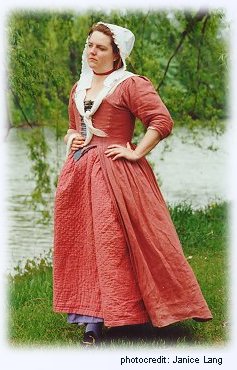
By Nancy Watt
Women and War in 18th Century North America
In general women were rarely active participants in the business of war. The occasional young farm wife might visit her husband in camp, if that camp was within travelling distance, and small numbers of women were official campfollowers. (Campfollowers were a small group of women assigned to a company of the regiment. They were often chosen by lottery. In return for sewing and laundry duties they received partial rations for themselves and their children.) The average woman was unlikely to be involved in the business of war. Civilians were often merely used as suppliers, billeters or servants to the army. However, the American Revolution was a civil war, and as such, the rules of engagement changed and people, regardless of gender and from all walks of life, got caught up in the maelstrom.
Although popular American mythology has canonized the role of the “patriot” woman, very little knowledge has been preserved about the role of women who, for whatever reason, stayed true to her government and became an enemy in her own country.
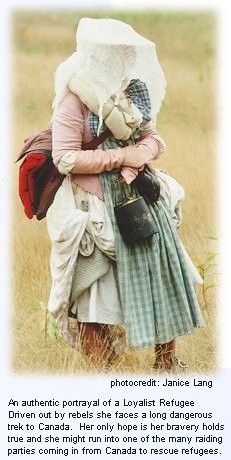
Enemies in their Own Country
“The Women of those Enemies is still living among us, some behave very rudely at present, and have proved very active to support and spirit up the opposite Cause…”
Excerpt from the minutes, August 25 1777, Chamber of Commitee for the County of Tryon…Mohawk Valley in the Revolution, Committe of Safety Papers & Genealogical Compendium….Marilyn B. Penrose
For a Variety of reasons, documentation on the status of women attached to the King’s Royal Yorkers is scant. Perhaps there was a less formal arrangement, because the Royal Yorkers were fighting on their home turf and did not expect their cause to be lost. When Sir John and his tenants made their original trek to Quebec to form the King’s Royal Regiment of New York, they left most of the women behind to keep the family farm or business operating and out of the hands of the rebels. Of course, once the war in the north was in full swing, the rebels found that confiscating a loyalist’s farm and evicting his woman and her children (grandparents, sisters, servants, etc.) was a popular act, and a sensible form of revenge. Not only did it satisfy the urge for retribution, but it also prevented another house from being a refuge or supply depot for loyalist scouting/raiding parties. And more and more loyalist homes were vandalized for the personal gain of rebel sympathizers and then sold cheap, often to a loyalist’s own nieghbour to help finance the rebel cause. Women and children were often physically and morally the hostages in this bitter frontier war.
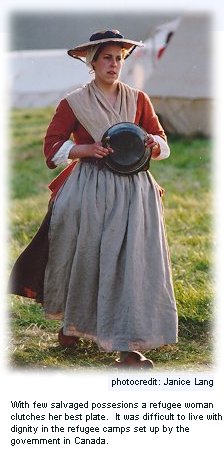 As the war progressed, more women and children found their way to the haven of the British Military Administration in Quebec. Sometimes they would be rescued by raiding parties from the north; sometimes they would band together and apply to the rebel government to be exchanged for rebel prisoners; sometimes they made their way on their own by selling possessions to raise money to hire a guide; and , some merely picked up their stuff and their children and fled. It is a testament to their strength and hardiness that many of them waited for an overtly hostile or violent action by local rebels (Somtimes their own neighbours) before they removed themselves to safety. And inevitably, some of them waited too long and died as a consquence.
As the war progressed, more women and children found their way to the haven of the British Military Administration in Quebec. Sometimes they would be rescued by raiding parties from the north; sometimes they would band together and apply to the rebel government to be exchanged for rebel prisoners; sometimes they made their way on their own by selling possessions to raise money to hire a guide; and , some merely picked up their stuff and their children and fled. It is a testament to their strength and hardiness that many of them waited for an overtly hostile or violent action by local rebels (Somtimes their own neighbours) before they removed themselves to safety. And inevitably, some of them waited too long and died as a consquence.
Once a female refugee reached one of the British bases in Quebec, in order to receive government aid she had to prove affiliation with a man who served the cause. Most women had been stripped of all their possessions or had been forced by the hardships of the route to leave them behind. All of them arrived in need of food, clothing and shelter. This was grudgingly provided by a Military Adminstration whose priorities lay elsewhere.
Canada was ill prepared to deal with the influx of refugees. Once billeting arrangements were exhausted, other solutions had to be found. Most women were sent to various refugee camps such as the one run by Seigneur Gugy at Machiche outside of Montreal. Imagine spending a Quebec winter in a hastily constructed barracks in horribly overcrowded conditions!
It is clear from both primary records and the increasing size of families over the war that some Yorker women were allowed to visit their men when the regiment was in garrison in Quebec Province. What is not as clear is in what capacity they were allowed to do so. Were these sanctioned conjugal visits, or were they official camp followers, or did they sneak in?
The only record of any women following the King’s Royal Regiment on campaign occurs in accounts of the 1777 St.Leger Expedition. Sir John’s wife, Lady Mary Johnson, and Sir John’s sister Anne Claus joined the army in the expectation that the expedition would succeed in retaking the Mohawk Valley and their homes. Thus the female reenactors of the King’s Royal Yorkers represent refugees rather than campfollowers – – a very subtle difference, but important to commemorating the fortitude and hardships of these amazing women.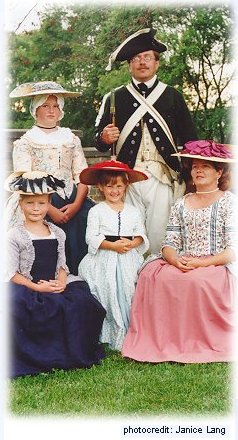
The Present Day
So, you are now scratching your head in wonderment, what does this mean that the modern Yorker woman does? Well, precious little is the obvious answer. Our main function is to look the part, look after oneself, and have fun. As we cannot carry farms with us and as it is unclear exactly what a refugee on a raiding party did with her spare time (if any), it is difficult to come up with gainful, accurate employment. So, while the men of the Royal Yorkers must conform to a schedule of drills and battles and etc., no such entertainment exists for the women and children. This does not mean that Yorker women never do any work. The labour of making oneself (and children) accurate clothes and accoutrements is an ongoing process; however, most of a woman’s work does not take place at the average event.
Because there are a minimal number of accurate activities to participate in, the Yorker women have attempted to pay strict attention to accuracy in clothing. This means tht we discourage extremes of presentation and encourage conservatism in fabric and pattern choices. Most of the time, we portray reasonably respectable farm wives, although once every couple of years or so we celebrate Polly Johnson Day, a day where we all dress in our best to honour the belle from New York City who married Sir John and endured many hardships and personal tragedy in the cause of loyalism.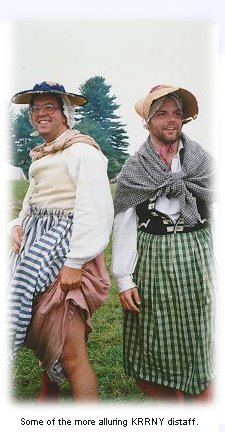
Belonging
The Royal Yorkers belong to several umbrella organizations. The Royal Yorker Refugees follow the exacting clothing guidelines set down by the Brigade of the American Revolutionfor their Civilian Class Membership with only a few of our own deviations. We are very proud of our section of the regiment and welcome discriminating participants who are happy to abide by our standards. Membership in the Loyal Refugees involves a one-timefee of $10 for a starter kit and a yearly fee of $5 to help us with our fabric fund and help fund the Distaff Bulletin, our newsletter, which is published 2 to 6 times a year as events warrant. Our section has a serjeant and a corporal and a position on the Yorker Executive Committee. Most of the women who join the Royal Yorkers do so through an affiliated man, however this does not have to be the case. If you have the money, time, sewing skills and the historical interest, please contact Amanda Moore.